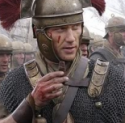|
Kaal posted:My understanding of the power of the maniple was that it creates much more flexibility in rough terrain. The phalanx was developed specifically for the flat plains of Greece. A city-state could put together one big unflankable line, and walk forward in formation. It was highly effective because anyone who didn't follow the same strategy would end up on the business end of a 9-foot pike. You're confusing the Greeks and Macedonians (And spears and pikes). This post is accurate enough to describe your average city-state war in Greece proper, but doesn't apply to the immense lands that were considered a part of the hellenic world. The Macedonians were the ones to use the long 9ft pikes in their armies, and managed to bring them all the way to India. These pikes were a great deal longer than a hoplite's spear and that made a lot of trouble for the Greeks. You're right in calling the phalanx, Macedonian or otherwise, inflexible. Rome smashed the Antigonid Macedonians at Pydna because they couldn't get past some rocks on the battlefield. But it isn't right to dismiss the phalanx as some hokey backwards formation that stuck around for no reason. The phalanx was integral to the Macedonians because their army was cavalry dominated. An inflexible but near-impervious wall of spears was perfect for them, because their horsemen could roll up any opposing cavalry and then turn and obliterate the hapless enemy infantry stuck against a phalanx. The Romans had kinda poo poo cavalry, so they went the other direction and built themselves an army based around the infantry unit. The thing is, by the time Rome came up in the world, all the states using Alexander's tactics had been fighting for decades to no end, so it wasn't quite like fighting the old Macedonians. Rome pretty much rolled up Macedonia, Ptolemaic Egypt and the Seleucid Empire without breaking a sweat. At Gaugemela, there were 7000 of the finest horsemen out of the 47,000 man Macedonian army. At Pydna, their 44,000 man army had a grab-bag of 4,000. We'll never know what would've happened if Rome encountered the sucessor states at their height. Ooooooo...
|
|
|
|

|
| # ? May 26, 2024 12:12 |
|
Alot of this makes a shitload of sense. I've always thought of the Roman legions as having the staying power of heavy infantry, but organisation allowing the mobility of relatively lighter infantry. I still can't help but wonder, surely a line of spears does better than a line of gladii?
|
|
|
|
Phobophilia posted:I still can't help but wonder, surely a line of spears does better than a line of gladii? In certain circumstances. The phalanx doesn't totally vanish until the idea of arming soldiers with pointy sticks vanishes, but it's only used in particular situations where it's highly effective, like against a cavalry charge. The line of spears is okay, but Romans were heavily armored and spears can be broken. A solid wall of legionaries doesn't present much of a target. You have a helmet, then an open spot where the eyes are. Next is the scutum, the big shield which covers most of the body. Below that there's one leg forward and exposed, but would often have an armored shin guard. The feet are vulnerable but good luck hitting them. Pack this in so the shields are all touching and it's going to be very difficult to hit anybody. The Romans push in, and once you're inside the spear point by a foot or two now you are a dude with a really long pole that you can't turn against another dude with a sword. Bad times. This is a worst case scenario though. It seems that usually the phalanx's inability to maneuver would be its downfall, the Romans could just get around the spears and go to town on an essentially defenseless flank. And you know, I'm not making GBS threads on the phalanx. It was very effective for a long time, dominated Mediterranean militaries for centuries. People just figured out a better way of fighting that let them defeat it. Grand Fromage fucked around with this message at 13:42 on Nov 3, 2012 |
|
|
|
Plus the Romans were disciplined as gently caress, weren't they? So not only do you have to contend with their superior equipment but their training as well. Unless you have them vastly outnumbered or have the type of army that can exploit massed infantry (say, horse archers) it's unlikely that their line is going to break before yours does, because their discipline was unrivaled for most of their existence.
|
|
|
|
Slim Jim Pickens posted:You're confusing the Greeks and Macedonians (And spears and pikes). This post is accurate enough to describe your average city-state war in Greece proper, but doesn't apply to the immense lands that were considered a part of the hellenic world. The Macedonians were the ones to use the long 9ft pikes in their armies, and managed to bring them all the way to India. These pikes were a great deal longer than a hoplite's spear and that made a lot of trouble for the Greeks. The hoplite spear was about 8 feet long, the Sarissa was around 18 feet long with the successor states going all the way to 22 feet.
|
|
|
|
Vigilance posted:Plus the Romans were disciplined as gently caress, weren't they? So not only do you have to contend with their superior equipment but their training as well. Unless you have them vastly outnumbered or have the type of army that can exploit massed infantry (say, horse archers) it's unlikely that their line is going to break before yours does, because their discipline was unrivaled for most of their existence. Along with discipline, from what I can recall, they rotated the front lines so fresh people were up front and poking sharp things at the other guys. I'm not sure how many other armies would do that and if not, that would give the Romans a big advantage the longer the fight went on. I'm not sure how well it could even be implemented by a phalanx with the guys holding such long rear end spears.
|
|
|
|
Retarded Pimp posted:Along with discipline, from what I can recall, they rotated the front lines so fresh people were up front and poking sharp things at the other guys. I'm not sure how many other armies would do that and if not, that would give the Romans a big advantage the longer the fight went on. I'm not sure how well it could even be implemented by a phalanx with the guys holding such long rear end spears. As usual there's some controversy on the rotation but I believe they did it. In a phalanx it was impossible, the guy at the front has to fight until death or victory. Discipline (though phalanx armies tended to have decent discipline, you couldn't do a worthwhile phalanx without it) and always having a fresh soldier at the front made a huge difference.
|
|
|
|
One thing I don't understand is if the flexibility of the legions made it better than the phalanx, why didn't Medieval or Renaissance era armies copy the Romans instead of going back to a forests of pikes? Why was it "Pike and Shot" and not "Gladii and Shot"?
|
|
|
|
zyang31 posted:One thing I don't understand is if the flexibility of the legions made it better than the phalanx, why didn't Medieval or Renaissance era armies copy the Romans instead of going back to a forests of pikes? Why was it "Pike and Shot" and not "Gladii and Shot"? Because gladii aren't much good against cavalry, and pikes are. It wasn't so much the flexibility of the weapons that they were using, it was the formation.
|
|
|
|
Plus long pointy sticks are easier and cheaper to make than finely crafted swords. I doubt most medieval societies could have afforded to outfit their troops the way the Romans did. Couple that with how dominant cavalry became during the medieval era and you have an emphasis on anti cavalry weapons moreso than anti infantry ones. Romans were way ahead of their time with their ability to mass produce gear for their troops.
|
|
|
|
WoodrowSkillson posted:The hoplite spear was about 8 feet long, the Sarissa was around 18 feet long with the successor states going all the way to 22 feet. Ugh, I'm so bad at gauging lengths. Medieval societies didn't operate on the "Forest-of-Pikes" system. That's a late Rennaisance thing. They were pretty hung up on heavy cavalry and all that. Pike formations weren't sensible for most medieval lords, because they take a lot of training and discipline. Why bother with a peasant levy? How can you even guarantee picking up the same peasants next year? Renaissance mercenaries rediscovered the pike and had the time to train themselves in that fashion. As states became more centralized, pikes became dominant. At the end of the day, it's still about discipline and training, and that's where the Romans excelled. They were the only professional army in Europe for like a thousand years.
|
|
|
|
Slim Jim Pickens posted:At the end of the day, it's still about discipline and training, and that's where the Romans excelled. They were the only professional army in Europe for like a thousand years. But it hasn't yet been thousand years since the fall of Constantinople...
|
|
|
|
Slim Jim Pickens posted:The thing is, by the time Rome came up in the world, all the states using Alexander's tactics had been fighting for decades to no end, so it wasn't quite like fighting the old Macedonians. Rome pretty much rolled up Macedonia, Ptolemaic Egypt and the Seleucid Empire without breaking a sweat. At Gaugemela, there were 7000 of the finest horsemen out of the 47,000 man Macedonian army. At Pydna, their 44,000 man army had a grab-bag of 4,000. We'll never know what would've happened if Rome encountered the sucessor states at their height. Ooooooo... This got missed and I love hypothetical history. Assuming the successor states had been less chaotic and more well organized, I still think the Romans would have won. It would have not been as easy though obviously. The Romans knew their cavalry was weak, and hurried to use the cavalry of everyone they conquered to shore up that weakness. The whole point of the phalanx was to be the anvil for the cavalry hammer. If the phalanx breaks, the gig is up, even if your cavalry dominates the opponent since now the infantry can adequately defend against charges. The Roman infantry and commanders were good enough that I think they would have outmaneuvered the Greeks eventually and fought battles on ground that favored them. The legions were just too good at exploiting weak points in the line of the enemy that sooner or later the phalanx would fall. I think it would have seriously slowed Rome's growth though as a formidable phalanx based army would have handed them some defeats instead of the near effortless wars that occurred. It is amazing that the Selucids got toppled so easily. An empire that stretched from Turkey to Iran to Israel and they got beat in a matter of years.
|
|
|
|
WoodrowSkillson posted:I think it would have seriously slowed Rome's growth though as a formidable phalanx based army would have handed them some defeats instead of the near effortless wars that occurred. It is amazing that the Selucids got toppled so easily. An empire that stretched from Turkey to Iran to Israel and they got beat in a matter of years. Sounds like another empire that got beat in a matter of years... empires built by one ethnic ruling class over a large territory of other groups often fall quickly if they lack native support.
|
|
|
|
Grand Fromage posted:As usual there's some controversy on the rotation but I believe they did it. In a phalanx it was impossible, the guy at the front has to fight until death or victory. Discipline (though phalanx armies tended to have decent discipline, you couldn't do a worthwhile phalanx without it) and always having a fresh soldier at the front made a huge difference. Thanks for this. I'd seen some discussion around whether the scene from Rome episode 1 where Vorenus rotates the front using a whistle (with legionaries in mo rearward ranks holding the rearward armor of those in front of them) was authentic, and had been meaning to ask about it here. I hadn't thought about it, but yeah, it's very hard to imagine someone with a sarissa being able to pull off that maneuver.
|
|
|
|
On the other hand, isn't the point of a Pike formation that almost everyone can fight no matter where they are in the formation? Pikes over the shoulders of the guys infront and all that. So even if some plucky swords/axemen get past the first lines pikes there's another bunch of pointy bits just a few feet facing them down the line.
|
|
|
|
sullat posted:Sounds like another empire that got beat in a matter of years... empires built by one ethnic ruling class over a large territory of other groups often fall quickly if they lack native support. The Seleucid empire at the point of Roman conquest consisted of Syria. The Parthians ate most of the old empire up, and the rest was lost due to infighting and the opportunistic border satraps. Central authority was a wreck due to their civil wars, so it wasn't a great surprise when they were made a Roman client state. Still, the empire "fell" in a very short period of time, but there were like a billion different causes.
|
|
|
|
Pimpmust posted:On the other hand, isn't the point of a Pike formation that almost everyone can fight no matter where they are in the formation? Pikes over the shoulders of the guys infront and all that. That only applied to the first few lines. Again this is one where we don't know exactly, but usually it's thought maybe the first three or four soldiers had their pikes leveled for fighting, and after that they were all held up at an angle to provide some deflection against arrows. When the guy at the front dies everyone moves up and gets into fighting position.
|
|
|
|
Weren't there a series of attempts at making Helenistic armies more mobile and agile? It's bizarre to think that things like the Thureophoroi and the Thorakites were actively frowned upon by the Helenistic states in favor of mass phalanx formations. From a logical point of view war was becoming more and more about flexibility and fluidity, and a 50k strong Macedonian army where at least ten thousand of them were of these new style would've been devastating against the Romans.Grand Fromage posted:That only applied to the first few lines. Again this is one where we don't know exactly, but usually it's thought maybe the first three or four soldiers had their pikes leveled for fighting, and after that they were all held up at an angle to provide some deflection against arrows. When the guy at the front dies everyone moves up and gets into fighting position. And that's why these formations were so fragile. What happens if the first guy dies and the second guy trips or slips? What if he rushes with haste and gets killed instantly? If a single enemy can get in that hole then everyone loses their poo poo!
|
|
|
|
Grand Fromage posted:That only applied to the first few lines. Again this is one where we don't know exactly, but usually it's thought maybe the first three or four soldiers had their pikes leveled for fighting, and after that they were all held up at an angle to provide some deflection against arrows. Was this actually effective, though? I was under the impression that the pikes were held like that in the rear lines to avoid accidentally spearing those in the front.
|
|
|
|
Mans posted:Weren't there a series of attempts at making Helenistic armies more mobile and agile? Sure. That was the whole idea with the Macedonian style phalanx, breaking it into basically phalanx maniples gave them more maneuverability. The problem is that a 20 foot long pike is just not a maneuverable weapon. There's only so much you can do with formations. Hedera Helix posted:Was this actually effective, though? I was under the impression that the pikes were held like that in the rear lines to avoid accidentally spearing those in the front. No idea. It probably wouldn't hurt but it sure wasn't a testudo. It may also be an old bullshit theory, as I said ancient writers really didn't give us many specifics on battle tactics so speculation is rampant. Grand Fromage fucked around with this message at 02:50 on Nov 4, 2012 |
|
|
|
Grand Fromage posted:That only applied to the first few lines. Again this is one where we don't know exactly, but usually it's thought maybe the first three or four soldiers had their pikes leveled for fighting, and after that they were all held up at an angle to provide some deflection against arrows. When the guy at the front dies everyone moves up and gets into fighting position. IIRC most pike formations were more of a combined arms situation. You had pikemen, but there were also swordsmen, crossbowmen, halberdiers, etc., interspersed in order to provide the unit with some ranged capability and soldiers who could quickly engage with anyone who got too close. fake edit--this applies to later, middle ages era, I don't know about antiquity.
|
|
|
|
Grand Fromage posted:Sure. That was the whole idea with the Macedonian style phalanx, breaking it into basically phalanx maniples gave them more maneuverability. The problem is that a 20 foot long pike is just not a maneuverable weapon. There's only so much you can do with formations. Wouldn't it make more sense to go back to the classical hoplite then? They could, in theory, fight in formation and then split up into ridiculously small numbers all the way down to only two, the "lovers", who would could efficiently fight together, one in an offensive style while the other protected him. Or is the whole hoplite pair system a bunch of BS?
|
|
|
|
Dopilsya posted:IIRC most pike formations were more of a combined arms situation. You had pikemen, but there were also swordsmen, crossbowmen, halberdiers, etc., interspersed in order to provide the unit with some ranged capability and soldiers who could quickly engage with anyone who got too close. fake edit--this applies to later, middle ages era, I don't know about antiquity. That was definitely the case in the late medieval age, but in Classical Antiquity the idea of combined arms warfare was only just beginning. Greek city-states used hoplites (spearmen) and slingers, but that was really more of a staged battle than a combined arms exercise. Later Alexander's Macedonians also incorporated heavy cavalry and what we would think of as pikemen (aka spearmen with long two-handed weapons that cannot be thrown); his campaign can largely be seen as the initial proving grounds of combined arms technique. The advent of the Roman era sees a move away from the use of pikes in favor of spears, javelins, and swords. It takes quite a while for the weapons to reappear on the battlefield. But the increasingly specialized nature of Western medieval warfare finds a need for a defensive line that can ward off attackers while the crossbowmen do their work, and the pike fills this niche perfectly. Kaal fucked around with this message at 03:17 on Nov 4, 2012 |
|
|
|
Mans posted:Wouldn't it make more sense to go back to the classical hoplite then? They could, in theory, fight in formation and then split up into ridiculously small numbers all the way down to only two, the "lovers", who would could efficiently fight together, one in an offensive style while the other protected him. The hoplite used the phalanx too, with most of the same weaknesses. The Macedonian phalanx destroyed the older hoplite phalanxes of the Greeks during Philip's rise. Carrying a big heavy shield and a large spear only works if you are fighting in formation, its too slow and unwieldy one on one against a swordsman. Hoplites carried swords for close combat if things broke down, but normally that meant the poo poo was hitting the fan anyway. Spears were used all the time because they are cheap and easy to mass produce, not because they are the most effective hand to hand combat weapons. Normally if a spearman fought a swordsman, the spearman lost. As for the pairs thing I thought that was just Thebes who had the 300 warriors made up of 150 pairs of lovers.
|
|
|
|
A minor point, but the Carthaginians had professional armies contemporaneous with the Romans.
|
|
|
|
WoodrowSkillson posted:Spears were used all the time because they are cheap and easy to mass produce, not because they are the most effective hand to hand combat weapons. Normally if a spearman fought a swordsman, the spearman lost. It's probably worth noting that a Roman legionary carried two throwing spears in addition to their gladius. The heavier of which could be pressed into service as a traditional thrusting spear if a spear-wall was required. In fact until the Marian Reforms the primary components of a Roman legion remained spear-based, with the Velites (javelineers), Hastati (spearmen), and Triarii (pikemen) forming the bulk of the maniples. Kaal fucked around with this message at 03:24 on Nov 4, 2012 |
|
|
|
Kaal posted:In fact until the Marian Reforms the primary components of a Roman legion remained spear-based, with the Velites (javelineers), Hastati (spearmen), and Triarii (pikemen) forming the bulk of the maniples. This is only correct for the Camillian legions. That is until the mid 300s BC or so. After the Samnite Wars and the development of the Polybian legions the Hastati and Principes used swords and shields. Marius changed the organization and the recruitment, but not the base equipment.
|
|
|
|
Yeah, the only distinction between hastati and principes was age, they were armed the same. Triarii were the only primarily spear-armed soldiers at that point, then they went away with Marius' reforms.
|
|
|
|
Any suggestions on where I can find (good) information about diseases in the Roman Empire?
|
|
|
|
Mans posted:Wouldn't it make more sense to go back to the classical hoplite then? They could, in theory, fight in formation and then split up into ridiculously small numbers all the way down to only two, the "lovers", who would could efficiently fight together, one in an offensive style while the other protected him. I thought this was a joke post. The gay phalanx was an elite Theban unit, but it was very small. Splitting a formation of classical hoplites doesn't work great either, because spears are just less flexible weapons. I think some people are getting the impression that you could charge in and break up a phalanx by causing a ruckus in the pikes. It was a gigantic dense wall of sharp points. You would have trouble fitting in the gaps between the pikes, even without four guys trying to stab you. It takes some serious psychological fibre to stroll into that. You don't try to go through a phalanx, you go around it, unless it gets hopelessly hosed up like at Pydna (Marching through rock formations!  ). ).By the way, pikemen trained in the Macedonian fashion were called phalangites. They wore funny helmets that had a great big bulb protruding from the top. Just like Rome, the Macedonians copied this helmet from nearby barbarians.
|
|
|
|
Nenonen posted:But it hasn't yet been thousand years since the fall of Constantinople... Speaking of which, how did medieval Roman military evolve after the west fell? Specifically during the Komnenian period, since it seems like after that they started relying quite a bit on mercenaries. I'm assuming they still had one of the most disciplined professional armies in Europe during this time, but I never could find much information on what exactly the makeup of their army was like or the tactics they used were, aside from cavalry playing a larger role. Normie Chomsky fucked around with this message at 07:25 on Nov 4, 2012 |
|
|
|
euphronius posted:A minor point, but the Carthaginians had professional armies contemporaneous with the Romans. Did they? I thought their armies were mostly mercenary forces because they were loaded. Libyans, Iberians, Gauls, Numidians etc. I suppose mercenaries are the epitome of a professional army but not in the sense that we were discussing (a citizen army)? Hannibal's army in it's prime was badass though. As was Alexander's. They would probably fare well against any Roman army. In the same vein a question, what was the most skilled/experienced Roman military formation in history? Legions are so standardized that it's probably hard to put this down, but I figure there were forces that fought a lot under one commander and stood above even the others. Caesar's veterans from the Gallic War to Actium? Some forces in the Crisis of the Third Century?
|
|
|
|
Mixoux posted:Speaking of which, how did medieval Roman military evolve after the west fell? Specifically during the Komnenian period, since it seems like after that they started relying quite a bit on mercenaries. I'm assuming they still had one of the most disciplined professional armies in Europe during this time, but I never could find much information on what exactly the makeup of their army was like or the tactics they used were, aside from cavalry playing a larger role. I'm not expert, but the theme system was a pretty big development in how soldiers were recruited and paid for.
|
|
|
|
Iseeyouseemeseeyou posted:Any suggestions on where I can find (good) information about diseases in the Roman Empire? Depending on what you're looking to find and what counts as good information, it's difficult to find. I'd start at Doctors and Diseases in the Roman Empire and root around in the bibliography if there's something more specialized you're after.
|
|
|
|
Mixoux posted:Speaking of which, how did medieval Roman military evolve after the west fell? Specifically during the Komnenian period, since it seems like after that they started relying quite a bit on mercenaries. I'm assuming they still had one of the most disciplined professional armies in Europe during this time, but I never could find much information on what exactly the makeup of their army was like or the tactics they used were, aside from cavalry playing a larger role. Basically, they switched to the "theme" system starting in 500 or so. The specifics varied over time, but essentially, peasant-soldiers were give allotments of land in military districts (called themes). The allotments were big enough to support a family and allow the soldier to afford arms and armor. But the system had largely broken down by the Kommenei period. Loss of territory played a big role, but greedy nobles played a bigger one. They hated the system because ther were all these stupid peasants owning land that could be used to enrich the nobility instead! What a waste! So the Doukas emperors abolished the system before (and again, after) Manzikert. Prefering to rely on mercenaries. This didn't work out quite so well, they had to hire the Turks to get rid of the mercenaries, the crusaders to get rid of the Turks... eventually they got rid of the crusaders with their own troops from Trebizon and Morea, but by then the Turks had decided to stay. As far as the organization of the military, it varied from period to period. When the theme system was working, you had well-equipped veteran infantry backed by mercenary cavalry from loyal client states, and when it wasn't working, you had peasants with pitchforks backed by unreliable mercenaries. For a while, the Varangian Guard was used as heavy infantry, but after the disasters at Manzikert and Durazzo they were reduced to ceremonial bodyguards.
|
|
|
|
It did work for a while, up until at least 1000ish the Roman armies were still the best in Europe. Also they had dudes with flamethrowers and grenades so they were automatically awesome. Imagine how terrifying that must've been to be some peasant levy and see Roman soldiers able to spit jets of fire from their hands.
|
|
|
|
From what i've read the problem wasn't so much that the Romans had a bad army, it was simply the fact the their internal bickering was too much to handle, coupled with crusading armies that tended to help the romans by relieving them of all their gold and valuables while the phenomenal Turkish forces were too much to handle.Slim Jim Pickens posted:I thought this was a joke post. The gay phalanx was an elite Theban unit, but it was very small. Splitting a formation of classical hoplites doesn't work great either, because spears are just less flexible weapons. I was asking if this was actually true, because if not i've wasted two months worth of military classes  And again, in my language phalangites and phalanxes are the same thing, that's why i tend to call "phalangites" phalanxes and "phalanxes" hoplites
|
|
|
|
Mans posted:From what i've read the problem wasn't so much that the Romans had a bad army, it was simply the fact the their internal bickering was too much to handle, coupled with crusading armies that tended to help the romans by relieving them of all their gold and valuables while the phenomenal Turkish forces were too much to handle. This is basically my understanding too. They maintain the quality and discipline that were Roman hallmarks, but the empire was just constantly being assaulted on all sides, the Turks were badasses, the Crusaders hosed them up hard, there was all kinds of internal political strife, and every time they lost something they were that much less able to defend the next thing. It just slowly wore away at the empire until it couldn't maintain itself anymore, and even then it limped along a couple centuries longer than you'd expect. The reliance on mercenaries that happened later was also never a good thing for any state. It wasn't so bad in the Middle Ages since everybody did it, but going from a home-grown professional army to mercenaries usually was not a good sign for the health of your state.
|
|
|
|

|
| # ? May 26, 2024 12:12 |
|
physeter posted:- The manipular deployment LOOKS weaker than a single line. This is so important, and so rarely understood. The reality of classical warfare is that most battles must occur by consent. If the other side doesn't want to fight, they can just not give battle. Fabian strategy is based on this. So if you're looking to conquer without battling a protracted insurrgency or dealing with a siege, the enemy needs to be brought to battle against your superior force, and beaten badly. An enemy might have scoffed at the ragged looking frontliners and swarmed into the gaps, then the second line came up and then they were caught like meat in saw blade. Surrounded on three sides, retreat became difficult. This is a tough one to grasp today, where in simulations we always have a good idea of enemy deployments and numbers. Ancient commanders had some scouts, a hill and maybe a rough idea of how many guys were on the other side. This is highly speculative on my part, but I wouldn't be surprised if the manipular deployment was a psychological feint meant to encourage an unsuspecting, numerically superior foe to give battle against a smaller, more highly trained force. Which is what the Romans were, so, it makes sense to me.
|
|
|

























